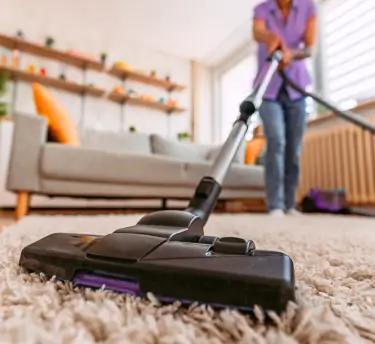Mold is a diverse group of fungi that lives just about anywhere. Certain types can cause allergic reactions and tough allergy symptoms.


Dust Mites: Protecting Your Family From This Common Allergen
With just a few household changes, you can help your family avoid these nasty little buggers and the allergy symptoms they can trigger.
Struggling with dust mite allergies can make being indoors very uncomfortable for you and your family. Fortunately, there are a number of things you can do to help reduce dust mites in your home and minimize this problem. We'll explain everything below, from the main symptoms of dust mite allergies to prevention tips, and more.
Since the 1960s, dust mites have been recognized as one of the most common triggers of indoor allergies. They cause symptoms in up to 2% of the general population, with even higher instances in specific regions like Europe and North America. Dust mites are accepted as a significant trigger of allergic rhinitis symptoms worldwide, with dust mite allergies affecting between 65 and 130 million people.1,2,3
Dust mites live in dead skin and hair and feed off of organic matter, such as dead skin and hair cells. They are often found in mattresses, carpets, upholstered furniture, and bedding. Therefore, it’s essential to understand the main symptoms of dust mite allergies, how to protect yourself, and how to help your family avoid these tiny, microscopic critters from affecting your daily life.1,3
How Do Dust Mites Multiply in Your Home?
Dust mites are tiny living creatures that are classified in the same family as spiders (arachnids). They thrive in warm, humid environments, which create the perfect living conditions for them to multiply throughout your home. Temperatures between 64 and 75ºF and over 70% humidity are the ideal conditions for the spread of dust mites.1
Dust mites can often be found hidden within mattresses, pillows, blankets, bedding, carpets, rugs, upholstery, and pretty much anything that collects dust in your home. The droppings left behind by these pesky mites can become airborne easily. When inhaled, these droppings can trigger an allergic reaction. And since dust mites often live in bedding, it’s common for people to inhale large amounts of these allergens while asleep.1,3,4
What Are the Symptoms of a Dust Mite Allergy?
For some, exposure to mites can trigger an allergic reaction, which then creates an inflammatory response in your nasal passages. When this happens, it can lead to many uncomfortable symptoms that resemble seasonal allergies (hay fever) or a common cold. Among the most prevalent symptoms are a runny nose, sneezing, and an itchy nose, throat, or eyes.4
Additionally, frequent flare-ups from dust mite allergies can have a negative impact on overall quality of life and family time if left unmanaged, due to these varied symptoms. Dust mite allergies can be found in as many as 50% of people with asthma worldwide. There's even evidence that dust mites may have the potential to trigger eczema flare-ups (atopic dermatitis) in some. That is to say, you and your family could also potentially develop a skin reaction to dust mites as well.2,4,5
Can Dust Mites Be Avoided?
During hot, humid seasons and in certain geographic locations, getting rid of dust mites completely can be an uphill battle—especially since dust mites are considered the most prevalent allergen in everyday house dust within humid climates. The good news is that if you and your family can limit or avoid coming into contact with dust mites, it’s possible to reduce allergy symptoms and find relief. Perhaps the simplest and most effective way to do this is to make simple, yet effective household changes—such as cleaning dust-prone areas more frequently.
Here are some recommendations to help keep dust at bay:
How To Manage Dust Mite Allergies
It's not always easy to adopt the above recommendations, especially if you have limited financial flexibility and a jam-packed schedule. Allergy medicines can also be used as an effective option to help relieve symptoms caused by dust mites. The first step to properly treating the issue is consulting with your doctor or allergist, as only they can make a proper diagnosis. They will help you to determine the specific triggers causing your allergy symptoms and craft the best personalized treatment plan for you and your family.4,6,7
Since it can be nearly impossible to completely remove all dust mites from your home, existing treatments—such as oral antihistamine options like Allegra Allergy®—can help relieve symptoms caused by dust mite allergies. For more persistent, severe cases, you and your doctor or allergist may explore additional options for treatment. This may include intranasal corticosteroids, nasal decongestants, immunotherapy (allergy shots), or other management options, as indicated by your doctor. 4,7,8
Related Articles
*Allegra is not indicated to relieve asthma or eczema. Allegra is indicated to relieve sneezing, runny nose, itchy, watery eyes, and itchy nose or throat. Allegra-D is indicated to relieve sneezing, runny nose, itchy, watery eyes, itchy nose or throat, nasal congestion, sinus pressure, and reduce swelling of the nasal passages.
†Among single-ingredient branded OTC oral antihistamines and OTC multi-ingredient allergy & decongestant brands. Excludes Allegra® Hives.
This article is not a substitute for medical advice. Allegra should be used as directed according to the product label. If you suspect that you have allergies, consult with your doctor or an allergist. Only they can make a proper diagnosis